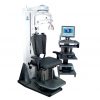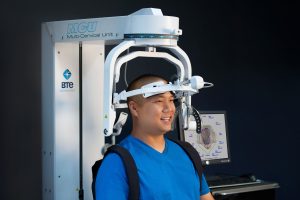
Treating Severe Neck Pain in Your Outpatient Rehab Clinic
Treatment GuidelinesYou don't have to be a spine specialist to safely and effectively treat sever neck pain. This evidence-based approach applies many of the same principles you use for other conditions. As always, start with evaluation. Consider the client’s ADLs, job tasks, degenerative changes within the spine, disease, and muscle imbalances.
Severe neck pain is a nearly permanent part of daily life for millions of Americans and millions more around the world. As widespread as it is, many rehab professionals avoid directly treating the neck and spine. But evidence shows that you can safely and effectively treat severe neck pain in your outpatient rehabilitation clinic. Read on to learn how.
It’s a Pain in the Neck!
Here are the facts. Neck pain is one of the most significant contributors to pain and disability in many countries. It is one of the top five of causes of disability. In addition, between 30%-50% of adults will experience neck pain at some point in their lives1. Approximately 50% of those will become chronic sufferers of these symptoms2.
What does chronic neck pain feel like? If you’ve ever woken up with a sore neck from sleeping in an odd position, multiply that by about 10. Add to it the inability to move your head comfortably, distraction and discomfort during the day, and difficulty sleeping at night from the pain. Severe neck pain can impact your everyday activities and certainly your overall comfort level.
Most of us can relate to this kind of pain. Some can get relief with better sleeping position, a massage, and some anti-inflammatory meds. But many people suffer from severe pain on a daily basis and need additional interventions.
The True Cost of Neck Pain
In addition to the toll it takes on your quality of life, it comes with financial and healthcare costs. People in the United States spent a total of $87.6 billion on neck pain in 20133. Those suffering from chronic neck pain can expect missed time at work, physical therapy, chiropractic care, and medical visits. We should also factor in the risk of becoming addicted to the opiates and other pain medications often used in severe pain treatment.
Evaluating Severe Neck Pain in Outpatient Rehab Clinics
Neck pain is such a widespread health issue that you likely have clients that can benefit from your treatment of it. The good news is that you don’t have to be a spine specialist to provide neck and back treatment. You can safely and effectively treat severe neck pain in an outpatient rehabilitation clinic.
Although it may be challenging, you don’t need a specialized program to treat neck and back pain. As always, start with evaluation. For many sufferers of severe neck pain, the pain is non-specific with unknown causes or contributory factors making evaluation challenging.
Keep in mind that your evaluation should include external factors that contribute to neck pain. Consider the client’s ADLs, job tasks, degenerative changes within the spine, disease, and muscle imbalances during evaluation4. Pay particular attention to work related activities, especially jobs that require lifting above shoulder level or with added vibration5.
Treating Severe Neck Pain in Outpatient Rehab Clinics
Based on your evaluation, treatment should target the muscles that attach to the cervical spine which can increase stability, control and movement. One factor that some practitioners overlook is neck strength symmetry. I recently presented a webinar with Physiquipe that discusses the role that muscular strength and symmetry play in neck pain. You can watch the webinar about treating whiplash-associated disorders (WAD) and chronic neck pain on demand here.
Published research supports the use of neck strengthening exercises for those suffering from severe neck pain. One study shows that an exercise program of 6-11 weeks decreased neck pain, increased isometric neck strength and reduced disability6. In this study, subjects were assigned to one of two groups, either an exercise group or control group.
After only six weeks of progressive resistive exercise using a dosed methodology, the subjects in the exercise group experienced better outcomes. They had higher increases in strength, greater decrease in pain and a greater reduction in their disability score when compared to the control group. Better yet, these were achieved with no invasive procedures or additional medications and can be accomplished within the clinical environment6.
BTE’s MCU Helps You Objectively Evaluate and Treat Severe Neck Pain
At BTE, we have spent over 40 years developing solutions to assessment and treatment needs of clinicians in a variety of disciplines. These solutions help you better treat the most challenging conditions and provide objective performance data. The Multi Cervical Unit (MCU) is just one more solution that can add value to your clinic’s offerings.
The MCU is a medical device developed by experts in treating cervical pain. It can help you evaluate and treat the cervical spine in your clinic. Start with an evaluation of your client’s cervical neck range of motion and isometric strength. The MCU provides easy-to-read reports that show the location and degree of deficits as well as any asymmetry between sides.
Once your initial evaluation is complete, the MCU facilitates exercises that target the specific areas of concern. You can completely tailor the exercise program to each client, with variable weight and customizable goals between sessions.
Want to find an MCU clinic near you? We can help. Use this form to find an MCU near you.
Knock Out Neck Pain in Your Clinic
Moving forward, neck pain that is associated with sport, military duties, work, day to day life, biomechanics, and other factors should be given more attention. Our aging population expects to maintain physical independence and a high level of activity. Severe neck and back pain will likely become more prevalent in the near future.
Thankfully, you have the capability to evaluate and treat severe neck pain in your own clinic. Check out the Multi-Cervical Unit (MCU) from BTE to see how you can relieve neck and back pain for your clients.
Jeffrey Johnson, MA, ATC
Clinical Specialist
BTE
References
- Goode, A., Freburger, J., and Carey, T. 2010. Prevalence, Practice Patterns and Evidence for Chronic Neck Pain. NCBI National Institute of Health. https://www.ncbi.nlm.nih.gov/pmc/articles/PMC2974793/
- Practical Pain Management. 2019. About Back/Spine, Neck and Shoulder Pain – The Statistics. Remedy Health Media. https://www.practicalpainmanagement.com/patient/conditions/low-back-pain/about-back-spine-neck-shoulder-pain-statistics
- Dieleman, J., Ranju, B., Birger, BS., et al. 2016. US Spending on Personal Healthcare and Public Health, 1996-2013. JAMA. 2016; 316(24), p2627-2646. https://jamanetwork.com/journals/jama/fullarticle/2594716
- Wang H, Jiang E, Wang K, Deng Z, Zhan H, Shen Z, Niu W: Shi’s Daoyin Therapy for Neck Pain: A Randomized Controlled Trial. Evidence Based Complementary and Alternative Medicine. 2018: ID4983891. 1-10. https://www.researchgate.net/publication/329622146_Shi’s_Daoyin_Therapy_for_Neck_Pain_A_Randomized_Controlled_Trial
- Caio G, Nicoly M, Thiago B, Sandra S, Alberto D: Prevalence and factors associated with neck pain: a population-based study. Brazilian Journal of Physical Therapy. 2017: July-Aug; 21(4) 274-280. https://www.ncbi.nlm.nih.gov/pmc/articles/PMC5537482/
- Chiu TTW, Lam TH, Hedley AJ: A randomized controlled trial on the efficacy of exercise for patients with chronic neck pain. Spine. 2005; 30(1): E1-E7 https://pubmed.ncbi.nlm.nih.gov/15626966/





